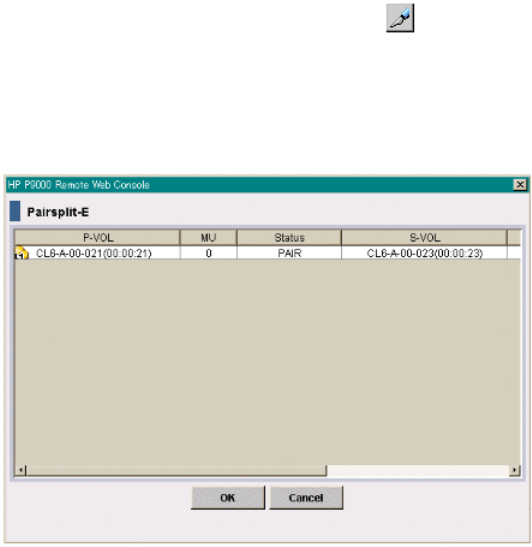HP XP P9000 Business Copy User Guide (AV400-96573, July 2013)
Table Of Contents
- HP XP P9000 Business Copy User Guide
- Contents
- 1 Business Copy overview
- 2 Requirements and planning
- 3 Sharing Business Copy volumes
- Cache Residency
- Fast Snap and Snapshot
- Data Retention
- Thin Provisioning and Smart Tiers
- External Storage Access Manager
- LUN Manager
- Open Volume Management
- Resource Partition
- Continuous Access Synchronous
- Continuous Access Journal
- External Storage
- Auto LUN
- 4 Performing configuration operations
- 5 Performing pair operations
- 6 Monitoring and maintaining the system
- 7 Troubleshooting
- 8 Support and other resources
- A Interface support for BC operations and options
- B Business Copy GUI reference
- Replications window
- Local Replications window
- View Pair Properties window
- View Pair Synchronous Rate window
- View Histories window
- Consistency Group Properties window
- Create Pairs wizard
- Split Pairs wizard
- Resync Pairs wizard
- Suspend Pairs window
- Delete Pairs window
- Edit Mirror Units dialog box
- Change Options dialog box
- Add Reserve Volumes Wizard
- Remove Reserve Volumes window
- Edit Local Replica Option wizard
- C Configuration operations (secondary window)
- D Pair operations (secondary window)
- E Monitoring and maintaining the system (secondary window)
- F Business Copy GUI reference (secondary window)
- Glossary
- Index

Prerequisite information
• On registering split time:
◦ When you register the Split time, you can only perform Suspend or Delete pair operations.
Split time is rejected if you perform Paircreate, Split, or Resync operation. If you want to
perform one of these operations, reset the registration of the Split time.
◦ The Split time you specified is reset when power is switched off.
◦ The operation is performed when the read/write request—with a time stamp past the
specified Split time—is received. The Split operation can be delayed if you do not issue
a read/write request. If I/O does not occur, the storage system timer performs the split
operation.
◦ If the Split time is registered, and if there is a pair in the consistency group that cannot
be split completely during the Split operation, the status of this pair remains the same as
before the Split operation.
1. Define a consistency group for the BC pairs that you will split using consistency group pair-split.
2. Specify the consistency group split option, then create the pairs.
3. Split the pairs in the consistency group. The pairs are split simultaneously.
Suspending pair creation
Suspending the creation of pairs (initial copy to the S-VOL) changes the pair status to PSUE. The
S-VOL continues accepting write I/O operations from the P-VOL and marks the entire P-VOL track
as difference data. Resynchronizing a suspended pair changes the pair status to COPY(RS)/COPY
and copies the entire P-VOL to the S-VOL. While the pairresync operation for a split pair can be
very fast, the pairresync operation for a suspended pair takes as long as the initial copy operation.
The storage system automatically suspends a pair when it detects an error condition related to an
update copy operation, or when it cannot keep the pair mirrored.
1. In RWC, click Actions > Local Replications > BC/SS > Pair Operation.
2. Change to Modify mode by clicking the icon.
3. In the tree, in the Pair Operations window, select the port or host group where the pairs or
volumes are located.
Related volumes are shown in the volume list. If a volume is already paired, pair information
is also shown.
4. Select the pairs that you want to suspend (or the volumes whose pairs you want to suspend),
right-click the selected pairs to show the menu, and select the Pairsplit-E command to open
the Pairsplit-E dialog box.
120 Pair operations (secondary window)










